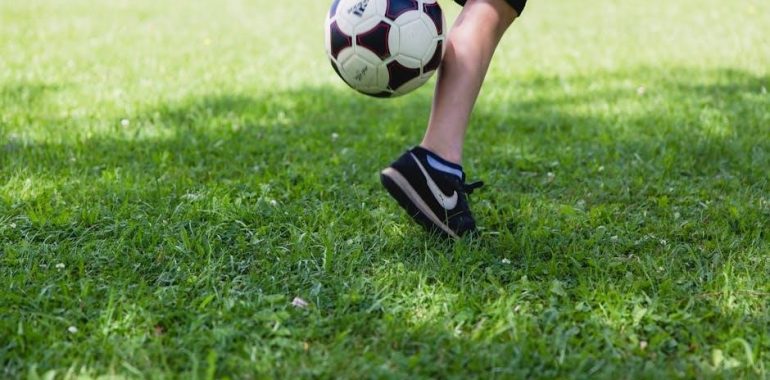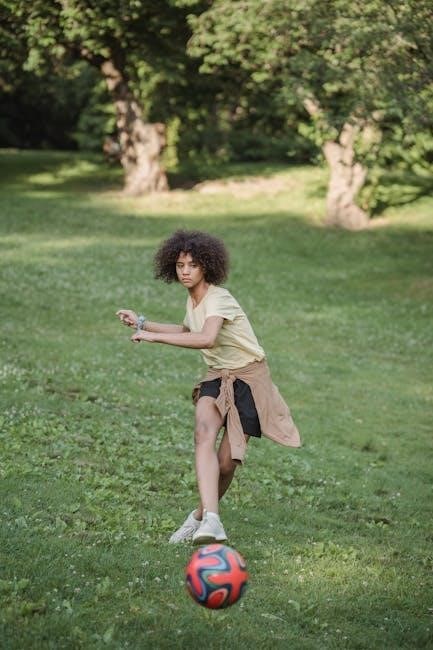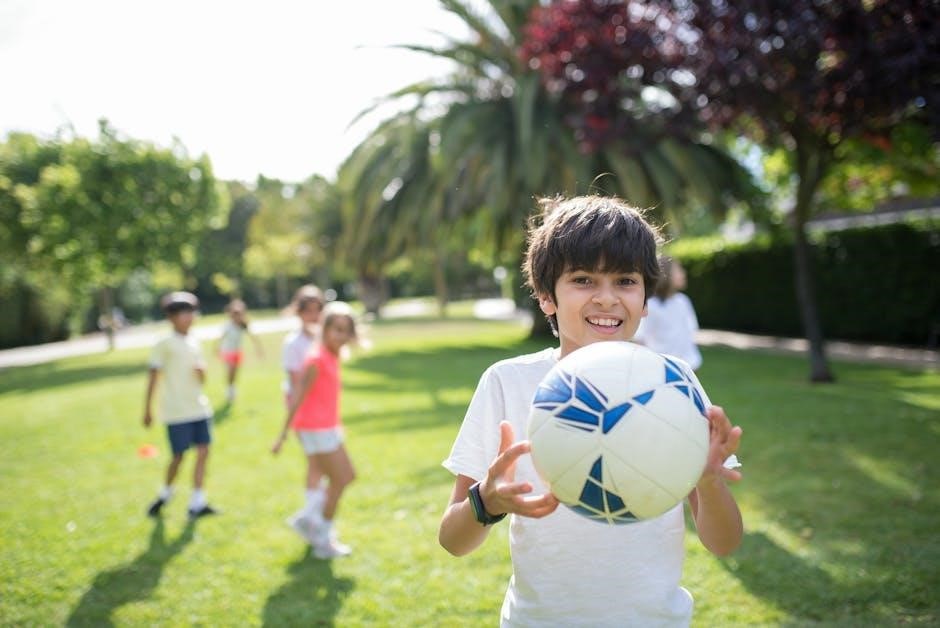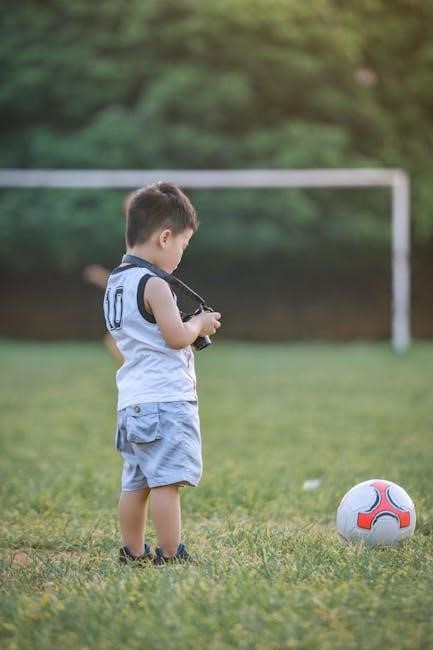youth soccer ball size guide

youth soccer ball size guide
Choosing the right soccer ball size is essential for young players’ development and safety. Youth soccer balls come in sizes 3, 4, and 5, catering to different age groups and skill levels. This guide helps parents and coaches select the perfect ball for their child, ensuring optimal performance and enjoyment of the game.
Importance of Choosing the Right Soccer Ball Size
Selecting the appropriate soccer ball size for youth players is crucial for their development, safety, and enjoyment of the game. A ball that is too large or too small can hinder a child’s ability to control and maneuver it effectively. Proper sizing ensures better technique, as younger players can practice dribbling, passing, and shooting with more precision. Additionally, the right size ball promotes safety, reducing the risk of injury from overly heavy or unwieldy equipment. Using a ball that matches the player’s age and skill level also builds confidence and improves performance. FIFA and USSF regulations provide clear guidelines to help parents and coaches make informed decisions. Investing time in choosing the correct size ensures a more enjoyable and productive soccer experience for children.
Overview of Available Soccer Ball Sizes
Soccer balls are available in several standardized sizes, primarily catering to different age groups and levels of play. The most common sizes are 3, 4, and 5, with size 5 being the official match ball for professional and adult games. Size 4 is typically used for youth players aged 8 to 12, while size 3 is designed for younger children under 8. These sizes vary in both circumference and weight, ensuring that younger players can handle the ball more easily. Additionally, size 1 and 2 balls are less common but may be used for training or promotional purposes. Understanding the differences in size and their intended use is key to selecting the right ball for developing skills and enjoying the game at every stage;
Official Soccer Ball Size Guide
The official soccer ball size guide outlines standardized measurements for youth and professional play. Size 3 balls measure 23-24 inches in circumference and weigh 280-340 grams. Size 4 balls are 25-26 inches and 350-390 grams, while Size 5 balls, used for older youth and adults, are 27-28 inches and 410-450 grams. These specifications ensure consistency across all levels of play, adhering to FIFA and USSF regulations for optimal performance and fairness in the game.
Size 3 Soccer Balls
Size 3 soccer balls are designed for young players aged 5-8 years, providing a smaller and lighter option to help develop ball control and technique. With a circumference of 23-24 inches and a weight of 280-340 grams, these balls are easier for smaller hands and feet to manage. Their reduced size allows for better precision in dribbling and passing, making them ideal for training and skill-building exercises. Size 3 balls are commonly used in Futsal and youth development programs, emphasizing fun and foundational skill development. Choosing the right size ensures young players can practice effectively and enjoy the game without unnecessary difficulty. This size is a transitional step toward larger balls as players grow and improve their abilities.
Size 4 Soccer Balls
Size 4 soccer balls are recommended for players aged 8-12 years, offering a balance between control and power. With a circumference of 25-26 inches and a weight of 350-390 grams, these balls are larger and heavier than Size 3, making them suitable for developing strength and technique. At this stage, players have better physical abilities to handle the increased size, allowing for more advanced training and competitive play. Size 4 balls are widely used in youth leagues and tournaments, helping to bridge the gap between smaller training balls and the standard Size 5. They are ideal for improving ball handling, shooting, and overall gameplay, ensuring young athletes can progress smoothly in their soccer journey. This size is a crucial step in preparing players for higher-level competition as they grow older and more skilled.
Size 5 Soccer Balls
Size 5 soccer balls are the largest and most widely used, recommended for players aged 13 and above, including professional and high school leagues. With a circumference of 27-28 inches and a weight of 410-450 grams, these balls are designed for advanced play, offering optimal control and power. They are the official size for competitive matches and are suitable for both training and gameplay. Size 5 balls are preferred by older players due to their larger surface area, which allows for better ball control and more precise shots. Transitioning to a Size 5 ball is a natural progression for young athletes as they develop their skills and physical strength. Using the correct size ensures proper technique and enhances the overall quality of play, making it essential for serious soccer enthusiasts and athletes aiming to excel in the sport.
Materials and Construction of Youth Soccer Balls
Youth soccer balls are made from synthetic, leather, or rubber materials. Synthetic balls are durable and water-resistant, while leather balls offer a traditional feel but require maintenance. Rubber balls are soft and ideal for training, ensuring safety and longevity for young players. The construction ensures proper weight, bounce, and control, catering to different skill levels and age groups. High-quality materials enhance performance and durability, making them suitable for both practice and competitive play. The choice of material impacts the ball’s responsiveness and lifespan, ensuring optimal playability for youth athletes. Each material type serves specific needs, providing versatility for various training and match conditions. The design prioritizes safety, comfort, and skill development, making it essential to select the right material for your child’s needs. The combination of innovative manufacturing and traditional craftsmanship ensures that youth soccer balls meet both performance and safety standards. By understanding the materials and construction, parents and coaches can make informed decisions to support young players’ growth and enjoyment of the sport.
Synthetic Soccer Balls
Synthetic soccer balls are crafted from durable, water-resistant materials like polyurethane or PVC, making them ideal for various playing conditions. They offer a soft, textured surface for better control and are lightweight, enhancing young players’ performance. Synthetic balls are more affordable and require less maintenance compared to leather ones, making them a popular choice for youth training. Their construction ensures consistent bounce and durability, even with frequent use. Parents and coaches often prefer synthetic balls for their longevity and versatility, as they perform well on both grass and artificial turf. The vibrant colors and patterns of synthetic balls also make them visually appealing. Overall, synthetic soccer balls are a practical and cost-effective option for developing skills in young athletes.
Leather Soccer Balls
Leather soccer balls are a traditional choice, offering a classic feel and superior touch for skilled players. Made from high-quality leather, these balls provide excellent control and aerodynamics. They are known for their soft, responsive surface, which enhances dribbling and passing precision. Leather balls require proper maintenance, such as occasional conditioning, to prevent drying out and cracking. While they are more expensive than synthetic options, they are favored by advanced players for their performance and durability. However, leather balls are heavier when wet and may not be ideal for younger players or training sessions. Despite these drawbacks, leather soccer balls remain a popular choice among professionals and enthusiasts, blending tradition with exceptional playability.
Rubber Soccer Balls

Rubber soccer balls are durable and ideal for younger players or training purposes. They are made from sturdy rubber materials, making them resistant to wear and tear. These balls are often used in recreational settings or for practices due to their ability to withstand rough play. Rubber balls are typically heavier and have a bouncier feel compared to synthetic or leather options. They are a cost-effective choice for parents and coaches seeking a long-lasting ball. However, they may lack the precision and aerodynamics of higher-end materials, making them less suitable for competitive matches. Despite this, rubber soccer balls are a practical option for developing skills and withstanding rigorous use in various playing conditions. Their durability ensures they remain a popular choice for youth training and casual games.

How to Choose the Right Soccer Ball for Your Child
Consider your child’s age, skill level, and the ball’s size, weight, and material. Consider consulting a size chart to ensure the ball meets safety and performance standards. Always check for proper inflation and durability to match their playing needs and preferences.
Key Factors to Consider When Selecting a Soccer Ball
When selecting a soccer ball for your child, several factors are crucial. First, consider the ball’s size, as it must align with your child’s age group to ensure proper control and safety. Next, evaluate the material—synthetic, leather, or rubber—each offering different levels of durability and feel. Weight is another important aspect, as a ball that is too heavy or too light can affect performance. Additionally, ensure the ball meets FIFA or USSF regulations for official play. Proper inflation is also essential for optimal performance. Finally, think about the ball’s intended use, whether for training, matches, or casual play, as this can influence the quality and features needed. By focusing on these elements, you can make an informed decision that supports your child’s development and enjoyment of the game.

FIFA and USSF Regulations for Soccer Ball Sizes
FIFA and USSF regulate soccer ball sizes to ensure fairness and safety. Size 3 is for ages 8 and under, Size 4 for 8-12, and Size 5 for 13+.
Official Guidelines for Youth Soccer Balls
Official guidelines for youth soccer balls are set by FIFA and USSF to ensure consistency and safety. These regulations specify that size 3 balls are designed for players aged 8 and under, size 4 for ages 8-12, and size 5 for players 13 and older. The circumference and weight of each size are standardized to meet the needs of different age groups. For instance, size 3 balls have a circumference of 23-24 inches and weigh 11-12 ounces, while size 4 balls measure 25-26 inches in circumference and weigh 13-15 ounces. Size 5 balls, used by older youth and adults, have a circumference of 27-28 inches and weigh 14-15 ounces. These guidelines help ensure proper ball control, skill development, and safety for young players. Adhering to these standards is crucial for an optimal playing experience.

Youth Soccer Ball Size Chart
The chart outlines size 3 for ages 8 and under, size 4 for ages 8-12, and size 5 for ages 13 and older, ensuring proper fit for skill development.
Age Groups and Corresponding Ball Sizes
Proper ball size is crucial for youth soccer development. Size 3 balls are recommended for children aged 8 and under, weighing 240-260 grams with a 23-24 inch circumference. Size 4 balls are ideal for ages 8-12, weighing 350-390 grams with a 25-26 inch circumference. Size 5 balls are designed for players aged 13 and older, weighing 410-450 grams with a 27-28 inch circumference. These guidelines ensure the ball is appropriate for the player’s strength, skill level, and safety. Using the correct size enhances technical skills and overall performance. Coaches and parents should refer to this chart to select the right ball for their child’s age group, fostering proper technique and enjoyment of the game. Correct ball size is essential for youth players to develop their abilities effectively.
Care and Maintenance of Soccer Balls
Regular inflation, cleaning with mild soap, and avoiding harsh chemicals extend a soccer ball’s life. Store in a dry place and avoid extreme temperatures for optimal durability.
Tips to Extend the Life of Your Soccer Ball
- Regularly check and maintain the recommended air pressure to prevent over-inflation, which can cause the bladder to stretch or the outer layers to crack.
- Use mild soap and water to clean the ball, avoiding harsh chemicals that can damage the materials or weaken the stitching.
- Store the ball in a cool, dry place, away from direct sunlight, to prevent the materials from degrading over time.
- Avoid using the ball on rough or abrasive surfaces, as this can wear down the outer layer and reduce its durability.
- For leather balls, apply a light layer of leather conditioner to keep the material supple and prevent cracking.
- After use, wipe off dirt and moisture to prevent mold or mildew from forming, especially in damp conditions.
- Inspect the ball regularly for any signs of wear, such as deflation, punctures, or loose stitching, and address issues promptly.
By following these care tips, you can ensure your soccer ball remains in great condition and performs well for a longer period.